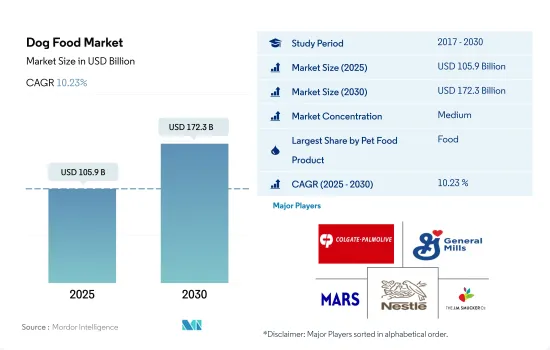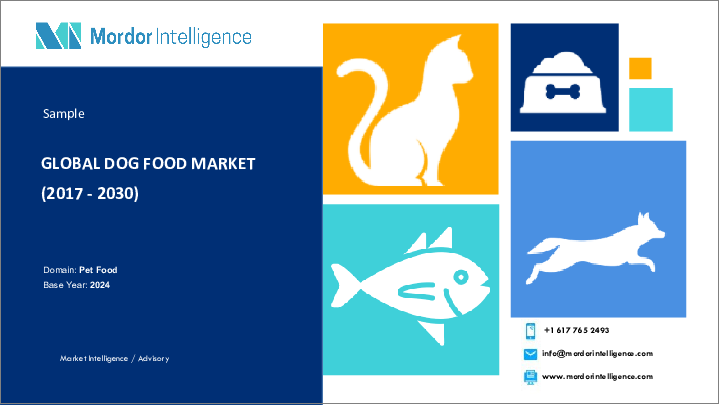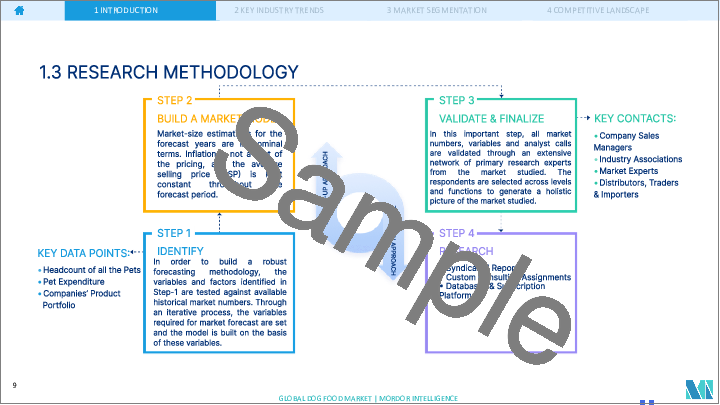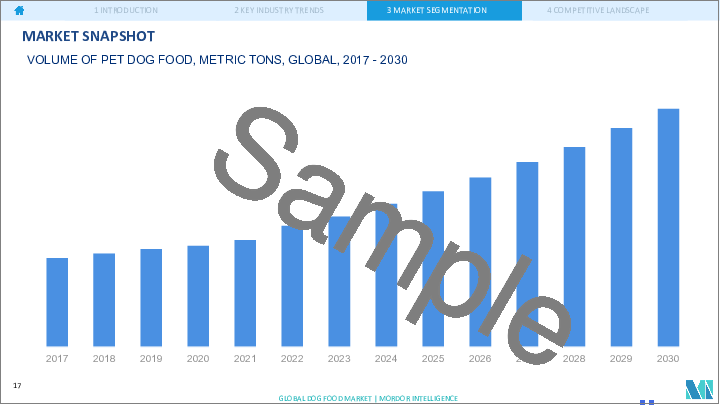|
|
市場調査レポート
商品コード
1686262
ドッグフード:市場シェア分析、産業動向・統計、成長予測(2025年~2030年)Dog Food - Market Share Analysis, Industry Trends & Statistics, Growth Forecasts (2025 - 2030) |
||||||
カスタマイズ可能
適宜更新あり
|
|||||||
| ドッグフード:市場シェア分析、産業動向・統計、成長予測(2025年~2030年) |
|
出版日: 2025年03月18日
発行: Mordor Intelligence
ページ情報: 英文 463 Pages
納期: 2~3営業日
|
- 全表示
- 概要
- 目次
ドッグフード市場規模は2025年に1,059億米ドルと推定され、2030年には1,723億米ドルに達すると予測され、予測期間中(2025年~2030年)のCAGRは10.23%で成長する見込みです。

世界のドッグフード市場は食品とおやつが大半を占め、ペットフードの主要セグメントとして動物用食事療法食が台頭
- 世界的には、市販のペットフードの消費量が多く、人口も多いことから、犬がペットフード市場を独占する主要ペットです。2022年、犬は世界のペットフード市場の48.7%を占めました。このシェアは、犬の飼育数の増加とプレミアム製品に対する需要の高まりにより、2017年から2022年の間に67.2%増加しました。例えば、犬の飼育数は2017年と比較して2022年には13.5%増加しました。ドッグフード市場ではフードセグメントが最大セグメントで、2022年の市場規模は547億米ドルです。これは、ペットフードが、ペットの犬種の大きさや年齢に関係なく、ほとんどの飼い主にとって主食として購入するものだからです。
- おやつは第2位の製品タイプで、2022年の市場規模は133億米ドルです。犬は他のペットよりもおやつを好みます。これらのおやつは、しつけ、歯の健康維持、ご褒美の提供など、複数の目的を果たします。犬用おやつ市場は、予測期間中にCAGR 10.6%を記録すると予測されています。
- ペット用動物飼料は、尿路疾患、腎不全、消化過敏症など、ペットの特定の健康状態に対処するために特別に処方されます。また、特定の健康問題の開発を避けるための予防措置としてペットに与えられることもあります。予測期間中、ペット用動物用飼料は、こうした特殊製品の需要が高まっていることから、CAGR 11.6%と最も高い伸びを示すと予想されます。
- ペット用栄養補助食品市場は、特に犬の健康懸念の高まりによる健康的な食事に対する意識の高まりが原動力となり、2017年と比較して2022年には19.7%増加しました。
- 市場は、犬の飼育数の増加、犬特有の健康ニーズ、犬の飼い主の健康意識の高まりによって牽引されています。予測期間中のCAGRは10.3%と予測されています。
可処分所得の増加と飼い主のペット化により北米が市場を独占
- 世界のドッグフード市場は近年著しい成長を遂げています。2022年には、北米が世界のドッグフード製品市場で最大の地域市場に浮上し、その金額は360億米ドルで、2017年から2022年の間に81.8%増加しました。この成長は、同期間に犬の飼育数が17.8%増加したこと、可処分所得が増加したこと、ペットの人間化の動向が高まったことが要因です。
- 欧州はドッグフードの2番目に大きい地域市場です。2022年には194億8,000万米ドルを占め、2029年には355億7,000万米ドルに達すると予測されています。これは、ペットの栄養に関する意識の高まり、グレインフリーやナチュラル製品に対する需要の高まり、予防的アプローチの採用、同地域における犬の飼育数の増加に関連しています。例えば、2022年の犬の飼育数は9,700万人で、2017年から14.2%増加しています。
- アジア太平洋は新興ドッグフード市場の一つです。2022年には世界のドッグフード市場の17.5%を占め、2017年から2022年の間に61.9%の大幅な成長を記録しました。これは、ペットの飼い主がますます市販のペットフード製品を選ぶようになったことと、この地域の人口が増えたことによる。2022年、アジア太平洋は世界の犬の飼育数の29.1%を占めました。
- アフリカと南米は、世界のドッグフード市場で最も急成長している地域で、予測期間中のCAGRはそれぞれ12.6%と12.4%と予測されています。この成長は、ペットの人間化の進展、ペット数の増加、家庭料理から市販のペットフードに移行する飼い主の多さに関連しています。
- 市販品の使用率が高いほどペット数は増加し、ペットの人間化傾向の高まりとともに、予測期間中のCAGRは10.3%で市場を牽引すると予想されます。
世界のドッグフード市場動向
北米とアジア太平洋は、進化するペット生態系と、動物保護施設からの養子縁組や購入のための犬の入手可能性により、犬の飼育数が最も多いです。
- 世界のペット数における犬のシェアは猫よりも高いです。世界的に、養子に迎える犬の好みは猫よりも高いです。その理由は、人々が犬により安心感を感じ、無条件の友情を築き、犬が飼い主の日常に適応する能力があるからです。過去5年間で、ペットの人間化が進み、世界的に犬の養子縁組が増加しています。米国や中国などの先進諸国では、犬を家族の一員として扱い、犬への感謝や動物愛護の文化が根付いているため、犬の高い養子率が見られました。例えば、2017年から2018年にかけて、米国では犬を家族の一員と考えるペットの親が85%のシェアを占めました。2020年には、犬を家族として扱う中国のペットペアレントは、ペット数全体の82.8%を占める。
- 北米とアジア太平洋はペットの犬の数が最も多く、2022年には54.6%のシェアを占める。これは、ペットのエコシステムが進化しており、動物保護施設やペットの購入やサービスを提供する店舗などのチャネルから、養子縁組や購入のために犬を入手できるためです。北米では、COVID-19パンデミックの間の文化からの仕事の増加とミレニアル世代がますます新しいペットを採用するため、2020年から2022年の間に愛犬の飼育数に9.6%の増加がありました。この影響はアジア太平洋、南米、欧州など他の地域でも見られます。犬の平均寿命は10~12年であるため、COVID-19パンデミックの影響は長期化すると予想されます。進化するペットの生態系、ペットの人間化の高まり、犬の無条件の友情は、世界の愛犬の飼育数を増加させる要因となっています。
市販のペットフード製品へのシフトが進んでいることが、世界の犬一頭当たりの支出増加につながっています。
- 調査期間中、犬に対するペット支出は増加しています。犬用ペット支出の増加は、プレミアム化の進展と健康への関心の高まりによるものです。これらの要因により、2017年から2022年の間に犬用ペット支出は36.4%増加しました。ペット支出に占める犬の割合は高く、2022年には39.4%に達しました。これは犬が猫よりもペットフードを多く消費し、専用のペットフードを与える傾向が強いためです。
- ペットを飼っている親は、ペットの健康に気を配るため、ペットフードに投資する割合が最も高いです。ペットのグルーミング、ペット・デイケア、散歩など、他のペットとの交流を深めるためのサービスも増えています。この動向は北米、欧州、アジア太平洋地域で見られます。例えば、インドでは、ペットの親はペディグリーやロイヤルカナンなどのブランドのおやつを犬に与えており、犬の支出(624米ドル)の約65~70%はペットフードに、20%はグルーミングやペットのデイケアなどの他の費用です。
- オンライン小売業者によるペットフード製品の購入は、犬の親たちの間で関心を集めています。この動向は北米やアジア太平洋などの地域で見られ、その理由はウェブサイト上でより多くの商品を入手できることと、異なる小売業者間で価格を比較できることにあります。例えば、2021年には、ペットフードをオンラインで購入する犬の飼い主は、インドのペットの親の73%を占めました。このように、インドにおける迅速なeコマース・ビジネスの進化は、ペットフードのオンライン販売を増加させると予想されます。
- プレミアム化の高まりとペットの健康への関心の高まりは、予測期間中にペットの支出を増加させると予想される要因です。
ドッグフード業界の概要
ドッグフード市場は適度に統合されており、上位5社で41.66%を占めています。この市場の主要企業は以下の通りです。 Colgate-Palmolive Company(Hill's Pet Nutrition Inc.), General Mills Inc., Mars Incorporated, Nestle(Purina)and The J. M. Smucker Company(sorted alphabetically).
その他の特典
- エクセル形式の市場予測(ME)シート
- 3ヶ月間のアナリストサポート
目次
第1章 エグゼクティブサマリーと主な調査結果
第2章 レポートのオファー
第3章 イントロダクション
- 調査の前提条件と市場定義
- 調査範囲
- 調査手法
第4章 主要産業動向
- ペット数
- ペット支出
- 規制の枠組み
- バリューチェーンと流通チャネル分析
第5章 市場セグメンテーション
- ペットフード製品
- フード
- サブプロダクト別
- ドライペットフード
- サブ製品別ドライペットフード
- キブル
- その他のドライフード
- ウェット・ペットフード
- ペット用栄養補助食品・サプリメント
- サブプロダクト別
- ミルクバイオアクティブ
- オメガ3脂肪酸
- プロバイオティクス
- タンパク質とペプチド
- ビタミンとミネラル
- その他の栄養補助食品
- ペット用おやつ
- サブプロダクト別
- カリカリおやつ
- デンタル・トリーツ
- フリーズドライ&ジャーキートリーツ
- ソフト&モチートリーツ
- その他のおやつ
- ペット用動物飼料
- サブプロダクト別
- 糖尿病
- 消化器過敏症用
- オーラルケア
- 腎臓
- 尿路疾患
- その他の動物用飼料
- フード
- 流通チャネル
- コンビニエンスストア
- オンラインチャネル
- 専門店
- スーパーマーケット/ハイパーマーケット
- その他のチャネル
- 地域
- アフリカ
- 国別
- 南アフリカ
- その他のアフリカ
- アジア太平洋
- 国別
- オーストラリア
- 中国
- インド
- インドネシア
- 日本
- マレーシア
- フィリピン
- 台湾
- タイ
- ベトナム
- その他のアジア太平洋
- 欧州
- 国別
- フランス
- ドイツ
- イタリア
- オランダ
- ポーランド
- ロシア
- スペイン
- 英国
- その他の欧州
- 北米
- 国別
- カナダ
- メキシコ
- 米国
- その他の北米
- 南米
- 国別
- アルゼンチン
- ブラジル
- その他の南米
- アフリカ
第6章 競合情勢
- 主要な戦略動向
- 市場シェア分析
- 企業情勢
- 企業プロファイル
- ADM
- Clearlake Capital Group, L.P.(Wellness Pet Company Inc.)
- Colgate-Palmolive Company(Hill's Pet Nutrition Inc.)
- General Mills Inc.
- Heristo Aktiengesellschaft
- Mars Incorporated
- Nestle(Purina)
- PLB International
- Schell & Kampeter Inc.(Diamond Pet Foods)
- The J. M. Smucker Company
第7章 CEOへの主な戦略的質問
第8章 付録
- 世界概要
- 概要
- ファイブフォース分析フレームワーク
- 世界のバリューチェーン分析
- 市場力学(DROs)
- 情報源と参考文献
- 図表一覧
- 主要洞察
- データパック
- 用語集
The Dog Food Market size is estimated at 105.9 billion USD in 2025, and is expected to reach 172.3 billion USD by 2030, growing at a CAGR of 10.23% during the forecast period (2025-2030).

Food products and treats dominate the global dog food market, with veterinary diets emerging as the major pet food segment
- Globally, dogs are the major pets dominating the pet food market due to the higher consumption of commercial pet food and high population. In 2022, dogs held 48.7% of the global pet food market. The share increased by 67.2% between 2017 and 2022 due to the rising dog population and the growing demand for premium products. For instance, the dog population grew by 13.5% in 2022 compared to 2017. The food segment is the largest segment in the dog food market, valued at USD 54.7 billion in 2022. This is because pet food is a staple purchase for most pet owners regardless of their pet breed size or age.
- Treats were the second-largest product type, amounting to a market value of USD 13.3 billion in 2022. Dogs show a preference for treats over other pets. These treats serve multiple purposes, including training, maintaining dental health, and providing rewards. The dog treats market is projected to witness a CAGR of 10.6% during the forecast period.
- Pet veterinary diets are specifically formulated to address specific health conditions in pets, such as urinary tract diseases, renal failure, and digestive sensitivity. They may also be given to pets as a preventative measure to avoid developing specific health issues. During the forecast period, pet veterinary diets are expected to register the highest CAGR of 11.6%, as there is a growing demand for these specialized products.
- The pet nutraceuticals market increased by 19.7% in 2022 compared to 2017, driven by the growing awareness of healthy diets, particularly due to rising health concerns in dogs.
- The market is driven by the increasing dog population, the specific health needs of dogs, and the growing awareness of health among dog owners. It is projected to witness a CAGR of 10.3% during the forecast period.
North America dominates the market due to increased disposable incomes and higher pet humanization among pet owners
- The global dog food market has witnessed significant growth in recent years. In 2022, North America emerged as the largest regional market in the global dog food product market, with a value of USD 36.0 billion, which increased by 81.8% between 2017 and 2022. This growth was driven by the dog population increasing by 17.8% in the same period, increasing disposable incomes, and the rising trend of pet humanization.
- Europe is the second-largest regional market for dog food. In 2022, it accounted for USD 19.48 billion, and it is projected to reach 35.57 billion by 2029. It is associated with increasing awareness about pet nutrition, rising demand for grain-free and natural products, adoption of preventive approaches, and increased dog population in the region. For instance, the dog population in 2022 was 97.0 million, increasing by 14.2% since 2017.
- Asia-Pacific is one of the emerging dog food markets. In 2022, it accounted for 17.5% of the global dog food market, recording a significant growth of 61.9% between 2017 and 2022. This was due to pet owners increasingly opting for commercial pet food products and the higher population in the region. In 2022, Asia-Pacific accounted for 29.1% of the global dog population.
- Africa and South America are the fastest-growing regions in the global dog food market, with projected CAGRs of 12.6% and 12.4%, respectively, during the forecast period. This growth is associated with the increasing pet humanization, growing pet population, and a large number of pet owners shifting from home-cooked food to commercial pet food.
- The higher usage of commercial products increased the pet population, which, along with the rise in pet humanization trends, is expected to drive the market with a CAGR of 10.3% during the forecast period.
Global Dog Food Market Trends
North America and Asia-Pacific have the highest dog populations due to evolving pet ecosystems, along with the availability of dogs for adoption and purchase from animal shelters
- Dogs have a higher share than cats in the global pet population. Globally, the preference for dogs to be adopted is higher compared to cats because people feel more secure with dogs, form unconditional friendships, and the ability of dogs to adapt to their owner's routine. Over the past five years, there has been a rise in pet humanization, which has also helped in increasing the adoption of dogs globally. In developed countries such as the United States and China, a high adoption rate of dogs was witnessed as they treat their dogs as family members and have a strong culture of dog appreciation and animal welfare. For instance, between 2017 and 2018, pet parents who consider dogs as family members accounted for an 85% share in the United States. In 2020, pet parents in China who treated their dogs as family members accounted for 82.8% of the total pet population.
- North America and Asia-Pacific have the highest number of pet dogs, accounting for a 54.6% share in 2022, owing to the evolving pet ecosystem and the availability of dogs for adoption and purchase from channels such as animal shelters and stores offering pet purchases and services. In North America, there was an increase of 9.6% in the pet dog population between 2020 and 2022 due to the rise in the work-from-culture during the COVID-19 pandemic and Millennials increasingly adopting new pets. This effect was witnessed in other regions as well, such as Asia-Pacific, South America, and Europe. The impact of the COVID-19 pandemic is expected to last for a longer period, as the average lifespan of dogs is 10-12 years. The evolving pet ecosystem, rise in pet humanization, and unconditional friendship of dogs are the factors that have helped in increasing the global pet dog population.
The increasing shift toward commercial pet food products has contributed to the increase in the expenditure per dog globally
- There has been an increase in pet expenditure for dogs during the study period. The growth in pet expenditure for dogs is due to increasing premiumization and growing concerns about health. These factors helped increase pet expenditure for dogs by 36.4% between 2017 and 2022. Dogs accounted for a higher share of the pet expenditure, which reached 39.4% in 2022. This is because dogs consume more pet food than cats and are more likely to be fed specialized pet food.
- Pet parents invest the highest share of their pet expenditure on pet food as they are concerned about their pets' well-being. There has been a rise in providing other services such as pet grooming, pet daycare, and pet walking for better socialization with other pets. This trend has been witnessed in North America, Europe, and Asia-Pacific. For instance, in India, pet parents feed their dogs with treats from brands such as Pedigree and Royal Canin, and about 65-70% of the dog expenditure (USD 624) is toward pet food, whereas 20% is other expenses such as pet grooming and pet daycare.
- The purchase of pet food products through online retailers is gaining interest among dog parents. This trend was witnessed in regions such as North America and Asia-Pacific due to the availability of a higher number of products on the website and the ability to compare prices across different retailers. For instance, in 2021, dog owners who purchased pet food online accounted for 73% of Indian pet parents. Thus, evolving quick e-commerce business in India is expected to increase online pet food sales.
- The rising premiumization and growing concern for pet health are the factors anticipated to increase pet expenditure during the forecast period.
Dog Food Industry Overview
The Dog Food Market is moderately consolidated, with the top five companies occupying 41.66%. The major players in this market are Colgate-Palmolive Company (Hill's Pet Nutrition Inc.), General Mills Inc., Mars Incorporated, Nestle (Purina) and The J. M. Smucker Company (sorted alphabetically).
Additional Benefits:
- The market estimate (ME) sheet in Excel format
- 3 months of analyst support
TABLE OF CONTENTS
1 EXECUTIVE SUMMARY & KEY FINDINGS
2 REPORT OFFERS
3 INTRODUCTION
- 3.1 Study Assumptions & Market Definition
- 3.2 Scope of the Study
- 3.3 Research Methodology
4 KEY INDUSTRY TRENDS
- 4.1 Pet Population
- 4.2 Pet Expenditure
- 4.3 Regulatory Framework
- 4.4 Value Chain & Distribution Channel Analysis
5 MARKET SEGMENTATION (includes market size in Value in USD and Volume, Forecasts up to 2030 and analysis of growth prospects)
- 5.1 Pet Food Product
- 5.1.1 Food
- 5.1.1.1 By Sub Product
- 5.1.1.1.1 Dry Pet Food
- 5.1.1.1.1.1 By Sub Dry Pet Food
- 5.1.1.1.1.1.1 Kibbles
- 5.1.1.1.1.1.2 Other Dry Pet Food
- 5.1.1.1.2 Wet Pet Food
- 5.1.2 Pet Nutraceuticals/Supplements
- 5.1.2.1 By Sub Product
- 5.1.2.1.1 Milk Bioactives
- 5.1.2.1.2 Omega-3 Fatty Acids
- 5.1.2.1.3 Probiotics
- 5.1.2.1.4 Proteins and Peptides
- 5.1.2.1.5 Vitamins and Minerals
- 5.1.2.1.6 Other Nutraceuticals
- 5.1.3 Pet Treats
- 5.1.3.1 By Sub Product
- 5.1.3.1.1 Crunchy Treats
- 5.1.3.1.2 Dental Treats
- 5.1.3.1.3 Freeze-dried and Jerky Treats
- 5.1.3.1.4 Soft & Chewy Treats
- 5.1.3.1.5 Other Treats
- 5.1.4 Pet Veterinary Diets
- 5.1.4.1 By Sub Product
- 5.1.4.1.1 Diabetes
- 5.1.4.1.2 Digestive Sensitivity
- 5.1.4.1.3 Oral Care Diets
- 5.1.4.1.4 Renal
- 5.1.4.1.5 Urinary tract disease
- 5.1.4.1.6 Other Veterinary Diets
- 5.1.1 Food
- 5.2 Distribution Channel
- 5.2.1 Convenience Stores
- 5.2.2 Online Channel
- 5.2.3 Specialty Stores
- 5.2.4 Supermarkets/Hypermarkets
- 5.2.5 Other Channels
- 5.3 Region
- 5.3.1 Africa
- 5.3.1.1 By Country
- 5.3.1.1.1 South Africa
- 5.3.1.1.2 Rest of Africa
- 5.3.2 Asia-Pacific
- 5.3.2.1 By Country
- 5.3.2.1.1 Australia
- 5.3.2.1.2 China
- 5.3.2.1.3 India
- 5.3.2.1.4 Indonesia
- 5.3.2.1.5 Japan
- 5.3.2.1.6 Malaysia
- 5.3.2.1.7 Philippines
- 5.3.2.1.8 Taiwan
- 5.3.2.1.9 Thailand
- 5.3.2.1.10 Vietnam
- 5.3.2.1.11 Rest of Asia-Pacific
- 5.3.3 Europe
- 5.3.3.1 By Country
- 5.3.3.1.1 France
- 5.3.3.1.2 Germany
- 5.3.3.1.3 Italy
- 5.3.3.1.4 Netherlands
- 5.3.3.1.5 Poland
- 5.3.3.1.6 Russia
- 5.3.3.1.7 Spain
- 5.3.3.1.8 United Kingdom
- 5.3.3.1.9 Rest of Europe
- 5.3.4 North America
- 5.3.4.1 By Country
- 5.3.4.1.1 Canada
- 5.3.4.1.2 Mexico
- 5.3.4.1.3 United States
- 5.3.4.1.4 Rest of North America
- 5.3.5 South America
- 5.3.5.1 By Country
- 5.3.5.1.1 Argentina
- 5.3.5.1.2 Brazil
- 5.3.5.1.3 Rest of South America
- 5.3.1 Africa
6 COMPETITIVE LANDSCAPE
- 6.1 Key Strategic Moves
- 6.2 Market Share Analysis
- 6.3 Company Landscape
- 6.4 Company Profiles
- 6.4.1 ADM
- 6.4.2 Clearlake Capital Group, L.P. (Wellness Pet Company Inc.)
- 6.4.3 Colgate-Palmolive Company (Hill's Pet Nutrition Inc.)
- 6.4.4 General Mills Inc.
- 6.4.5 Heristo Aktiengesellschaft
- 6.4.6 Mars Incorporated
- 6.4.7 Nestle (Purina)
- 6.4.8 PLB International
- 6.4.9 Schell & Kampeter Inc. (Diamond Pet Foods)
- 6.4.10 The J. M. Smucker Company
7 KEY STRATEGIC QUESTIONS FOR PET FOOD CEOS
8 APPENDIX
- 8.1 Global Overview
- 8.1.1 Overview
- 8.1.2 Porter's Five Forces Framework
- 8.1.3 Global Value Chain Analysis
- 8.1.4 Market Dynamics (DROs)
- 8.2 Sources & References
- 8.3 List of Tables & Figures
- 8.4 Primary Insights
- 8.5 Data Pack
- 8.6 Glossary of Terms






